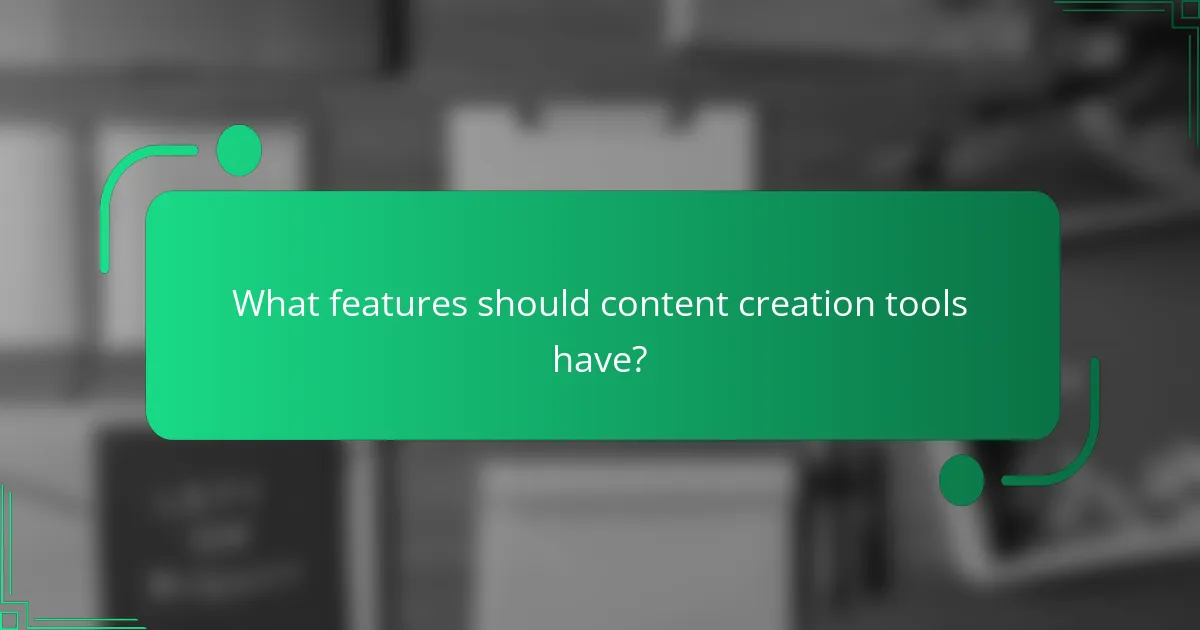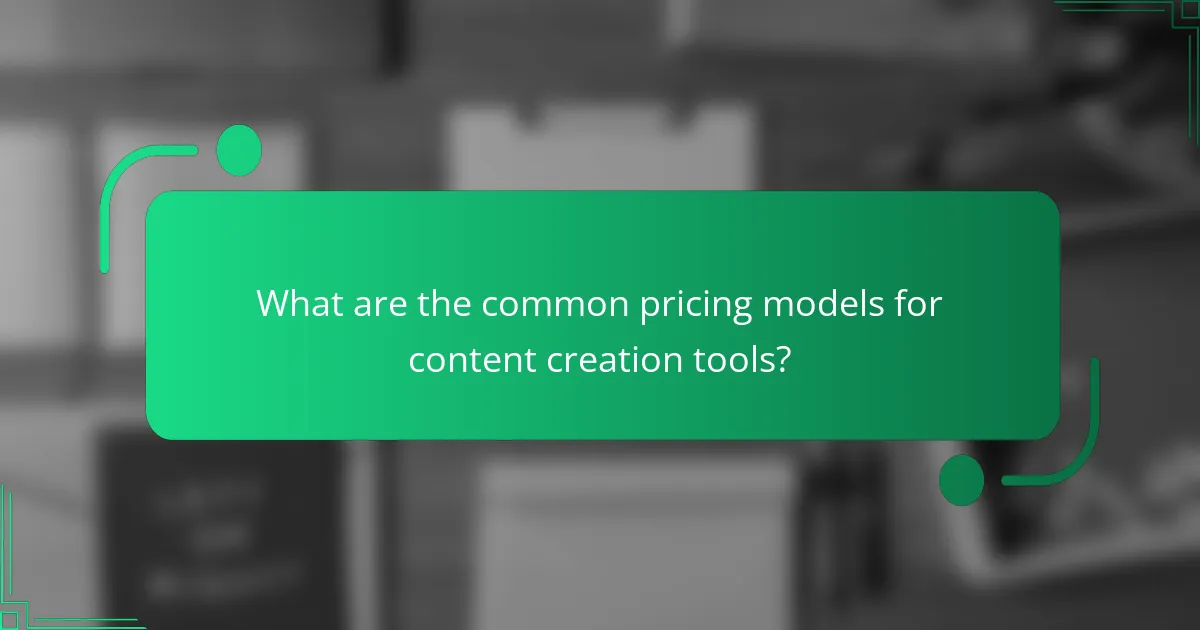In today’s digital landscape, selecting the right content creation tools is essential for marketers aiming to enhance productivity and streamline workflows. Tools like Canva, BuzzSumo, Grammarly, and Hootsuite cater to various needs, from graphic design to social media management. By evaluating usability, integration, and cost, marketers can choose solutions that not only improve content quality but also facilitate collaboration and provide valuable performance insights.

What are the best content creation tools for marketers?
The best content creation tools for marketers enhance productivity, streamline workflows, and improve the quality of content. Popular options include Canva, BuzzSumo, Grammarly, and Hootsuite, each serving specific needs in graphic design, content research, writing assistance, and social media management.
Canva for graphic design
Canva is a user-friendly graphic design tool that allows marketers to create visually appealing content without needing advanced design skills. It offers a wide range of templates for social media posts, presentations, and infographics, making it easy to produce professional-looking graphics quickly.
When using Canva, consider leveraging its collaboration features, which allow team members to work together in real-time. This can significantly speed up the design process and ensure that everyone is aligned on branding and messaging.
BuzzSumo for content research
BuzzSumo is a powerful tool for content research that helps marketers identify trending topics and popular content within their niche. By analyzing social media shares and engagement metrics, users can discover what resonates with their audience and tailor their content strategy accordingly.
To maximize BuzzSumo’s effectiveness, utilize its content alerts feature to stay updated on new articles and mentions of your brand or industry keywords. This proactive approach can help you stay ahead of competitors and capitalize on emerging trends.
Grammarly for writing assistance
Grammarly is an essential writing tool that provides real-time grammar and style suggestions, helping marketers produce clear and error-free content. It checks for common mistakes, tone, and readability, making it suitable for various writing formats, from blog posts to emails.
To get the most out of Grammarly, consider using its premium features, which offer advanced suggestions and plagiarism detection. This can be particularly useful for ensuring originality and maintaining a professional standard in your writing.
Hootsuite for social media management
Hootsuite is a comprehensive social media management platform that allows marketers to schedule posts, monitor engagement, and analyze performance across multiple social channels. This tool simplifies the process of managing social media accounts, saving time and ensuring consistent messaging.
When using Hootsuite, take advantage of its analytics features to track the success of your campaigns. Regularly reviewing these metrics can help you refine your strategy and improve your overall social media presence.

How to choose the right content creation tool?
Choosing the right content creation tool involves assessing your specific needs, including usability, integration with other platforms, and cost. A well-selected tool can enhance productivity and streamline your content workflow.
Assess user-friendliness
User-friendliness is crucial when selecting a content creation tool, as it directly impacts your team’s efficiency. Look for intuitive interfaces that require minimal training, allowing users to focus on content rather than navigating complex features.
Consider tools that offer templates and drag-and-drop functionality, which can simplify the content creation process. A user-friendly tool can significantly reduce the time spent on onboarding and increase overall satisfaction among team members.
Evaluate integration capabilities
Integration capabilities determine how well a content creation tool works with other software you use, such as project management or analytics tools. A good tool should seamlessly connect with platforms like Google Drive, WordPress, or social media channels to streamline your workflow.
Check for APIs and third-party integrations that can enhance functionality. Tools that support integrations can save time and reduce errors by automating data transfers and updates across platforms.
Consider pricing models
Pricing models vary widely among content creation tools, so it’s essential to find one that fits your budget while meeting your needs. Many tools offer subscription-based pricing, which can range from low monthly fees for basic features to higher costs for premium functionalities.
Evaluate whether a tool offers a free trial or tier, allowing you to test its features before committing. Be mindful of hidden costs, such as fees for additional users or premium features, which can impact your overall budget.

What features should content creation tools have?
Content creation tools should have features that enhance productivity, facilitate collaboration, and provide insights into performance. Key functionalities include collaboration options, template availability, and analytics and reporting capabilities, which collectively streamline the content development process.
Collaboration options
Effective collaboration options are essential for teams working on content projects. Look for tools that allow multiple users to edit simultaneously, leave comments, and track changes. Features like version control can help manage edits and ensure that everyone is on the same page.
Consider tools that integrate with popular communication platforms, such as Slack or Microsoft Teams, to facilitate real-time discussions. This integration can significantly reduce the time spent on back-and-forth emails and enhance team synergy.
Template availability
Template availability is crucial for speeding up the content creation process. A good content creation tool should offer a variety of customizable templates for different types of content, such as blog posts, social media updates, and newsletters. This can save time and ensure consistency across various formats.
When evaluating templates, check for user-friendly designs that align with your brand’s style. Some tools also allow you to create and save your own templates, which can be beneficial for maintaining a cohesive look and feel in your content.
Analytics and reporting
Analytics and reporting features help you measure the effectiveness of your content. Look for tools that provide insights into key performance indicators such as engagement rates, click-through rates, and conversion metrics. This data can inform future content strategies and highlight areas for improvement.
Consider tools that offer customizable dashboards for easy access to analytics. Regularly reviewing these reports can help you adapt your content to better meet your audience’s needs and preferences, ultimately driving better results.

What are the benefits of using content creation tools?
Content creation tools offer numerous advantages, including increased productivity, enhanced creativity, and improved content quality. These tools streamline the content development process, allowing creators to focus on generating engaging material rather than getting bogged down by technical details.
Increased efficiency
Using content creation tools can significantly boost efficiency by automating repetitive tasks and simplifying workflows. For instance, tools that offer templates or content calendars can save time in planning and organizing content schedules.
Additionally, many tools provide features like collaboration options, which enable teams to work together seamlessly, reducing the time spent on revisions and approvals. This can lead to faster turnaround times for projects.
Enhanced creativity
Content creation tools often come with built-in features that inspire creativity, such as brainstorming aids, design elements, and multimedia integration. These features allow creators to experiment with different formats and styles, leading to more innovative content.
For example, tools that offer stock images, video clips, or audio snippets can help creators incorporate diverse media into their work, making the final product more engaging for the audience.
Improved content quality
High-quality content is crucial for engaging audiences, and content creation tools can help achieve this by providing editing features, grammar checks, and SEO optimization suggestions. These functionalities ensure that the content is polished and adheres to best practices.
Moreover, tools that analyze audience engagement can provide insights into what works and what doesn’t, allowing creators to refine their approach and produce more effective content over time.

What are the common pricing models for content creation tools?
Content creation tools typically employ various pricing models, including subscription-based, one-time purchase, and freemium options. Understanding these models helps users choose the best tool for their needs and budget.
Subscription-based pricing
Subscription-based pricing is a popular model where users pay a recurring fee, usually monthly or annually, to access the content creation tool. This model often includes regular updates and customer support, making it appealing for users who want ongoing access to the latest features.
When considering subscription-based tools, evaluate the total cost over time, as monthly fees can add up. Many tools offer tiered pricing based on features, so assess which plan aligns with your specific requirements. Common price ranges can vary from around $10 to $50 per month, depending on the tool’s capabilities.
Be cautious of automatic renewals and cancellation policies. Always read the terms to avoid unexpected charges. Additionally, take advantage of free trials when available to test the tool before committing to a subscription.
